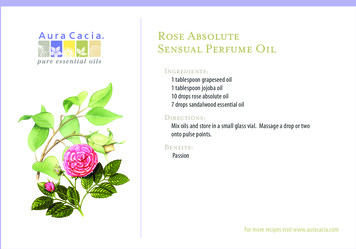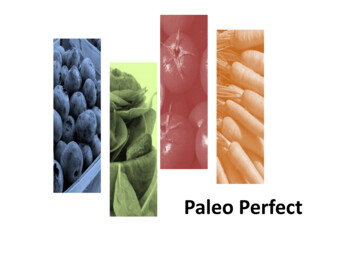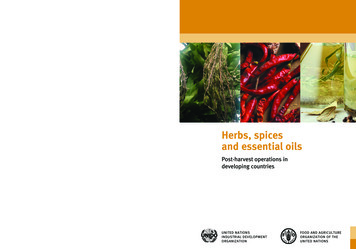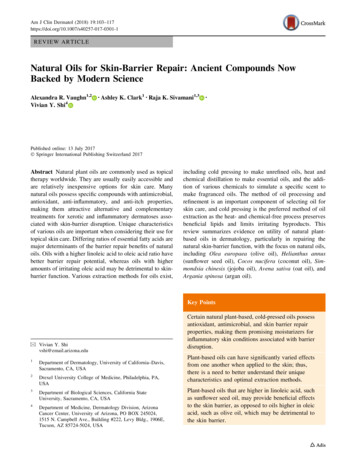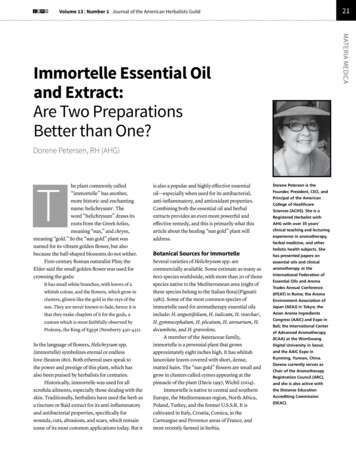
Transcription
J A H G21Volume 13 Number 1 Journal of the American Herbalists GuildMATERIA MEDICAImmortelle Essential Oiland Extract:Are Two PreparationsBetter than One?Dorene Petersen, RH (AHG)The plant commonly called“immortelle” has another,more historic and enchantingname: helichrysum1. Theword “helichrysum” draws itsroots from the Greek helios,meaning “sun,” and chryos,meaning “gold.” So the “sun gold” plant wasnamed for its vibrant golden flower, but alsobecause the ball-shaped blossoms do not wither.First-century Roman naturalist Pliny theElder said the small golden flower was used forcrowning the gods:It has small white branches, with leaves of awhitish colour, and the flowers, which grow inclusters, glisten like the gold in the rays of thesun. They are never known to fade, hence it isthat they make chaplets of it for the gods, acustom which is most faithfully observed byPtolemy, the King of Egypt (Newberry 430-431).In the language of flowers, Helichrysum spp.(immortelle) symbolizes eternal or endlesslove (Seaton 180). Both ethereal uses speak tothe power and prestige of this plant, which hasalso been praised by herbalists for centuries.Historically, immortelle was used for allscrofula ailments, especially those dealing with theskin. Traditionally, herbalists have used the herb asa tincture or fluid extract for its anti-inflammatoryand antibacterial properties, specifically forwounds, cuts, abrasions, and scars, which remainsome of its most common applications today. But itis also a popular and highly effective essentialoil—especially when used for its antibacterial,anti-inflammatory, and antioxidant properties.Combining both the essential oil and herbalextracts provides an even more powerful andeffective remedy, and this is primarily what thisarticle about the healing “sun gold” plant willaddress.Botanical Sources for ImmortelleSeveral varieties of Helichrysum spp. arecommercially available. Some estimate as many as600 species worldwide, with more than 20 of thosespecies native to the Mediterranean area (eight ofthese species belong to the Italian flora)(Pignatti1982). Some of the most common species ofimmortelle used for aromatherapy essential oilsinclude: H. angustifolium, H. italicum, H. stoechas2,H. gymnocephalum, H. plicatum, H. arenarium, H.decumbens, and H. graveolens.A member of the Asteraceae family,immortelle is a perennial plant that growsapproximately eight inches high. It has whitishlanceolate leaves covered with short, dense,matted hairs. The “sun gold” flowers are small andgrow in clusters called cymes appearing at thepinnacle of the plant (Davis 1997, Wichtl 2004).Immortelle is native to central and southernEurope, the Mediterranean region, North Africa,Poland, Turkey, and the former U.S.S.R. It iscultivated in Italy, Croatia, Corsica, in theCarmargue and Provence areas of France, andmost recently farmed in Serbia.Dorene Petersen is theFounder, President, CEO, andPrincipal of the AmericanCollege of HealthcareSciences (ACHS). She is aRegistered Herbalist withAHG with over 35 years’clinical teaching and lecturingexperience in aromatherapy,herbal medicine, and otherholistic health subjects. Shehas presented papers onessential oils and clinicalaromatherapy at theInternational Federation ofEssential Oils and AromaTrades Annual Conference(IFEAT) in Rome; the AromaEnvironment Association ofJapan (AEAJ) in Tokyo; theAsian Aroma IngredientsCongress (AAIC) and Expo inBali; the International Centerof Advanced Aromatherapy(ICAA) at the WonGwangDigital University in Seoul;and the AAIC Expo inKunming, Yunnan, China.Dorene currently serves asChair of the AromatherapyRegistration Council (ARC),and she is also active withthe Distance EducationAccrediting Commission(DEAC).
22Volume 13 Number 1 Journal of the American Herbalists GuildMATERIA MEDICAJ A H GHelichrysum italicum ssp.italicum in its naturalhabitat, the Adriatic coastalregion. Image reproducedwith permission from AnaRangus’ Essential oil andFlavour/Fragrance Sector inWestern Balkan Countries,a PowerPoint presentationdelivered at the 2014International Federation ofEssential Oils and AromaTrades (IFEAT) Conference inRome.But as previously mentioned, Helichrysum is alarge, widespread genus, aided by its xerophytenature (adaptation to survive in a dryenvironment). Much like fellow Asteraceae familymember Helianthus annuus (sunflower),immortelle will grow in poor-quality soil so long asit receives enough sun, though the plant preferssandy soil. In fact, Helichrysum spp. are dispersedfrom the lower-intermediate Mediterranean,growing at a wide range of altitudes from sea levelup to 1,700 meters (approximately 5,570 feet)above sea level, preferably in sandy or loamy soils(Perrini, Morone-Fortunato et al, 2009).Immortelle Essential Oil BackgroundImmortelle essential oil is distilled from theflowering tops of the plant. The plants shouldbe distilled when the flowers are fresh, as theDorene Petersen distillingimmortelle essential oil inGreece.Image by American College ofHealthcare Sciences. 2012flowers begin to ferment 24 hours after beingharvested, which can impact the constituentprofile and reduce the therapeutic efficacyof the essential oil. Since the yield is low, H.angustifolium is often distilled with othervarieties, like H. orientale. While this typicallywill improve the quantity of the yield, it willalso impact the constituent profile and create avery different end product. Ideally, immortelleessential oil that is used for clinical therapeuticaromatherapy is distilled from a single species.Immortelle absolute, which is solventextracted, is also available commercially.The solvent extraction method is frequentlyused to extract volatiles from flowersparticularly if the aromatic molecules withinthe flower cannot be extracted via steam.In solvent extraction, the flower petals arefirst mixed into a volatile solvent (such aspetroleum, ether, benzene, or hexane) until thevolatile components are completely dissolved. Thesolution is then filtered and the solvent isevaporated out at reduced pressure.The initial result of solvent extraction is calleda “concrete.” The concrete still contains insolublevegetable wax and pigments, so it is furtherprocessed by solvents and freezing to separate outthe waxes. The final product is the absolute. Mostof the solvent is removed from the absolute byvacuum pressure without using heat. However,there is usually a small amount of solvent
J A H G23Volume 13 Number 1 Journal of the American Herbalists GuildActive Constituents in ImmortellePreparationsThe “sun gold” yellow flowers of immortelle gettheir vibrant color from arenol and homoarenol,unique flavonoid constituents known as pyranonederivatives (Wichtl 2004). The flowers from theimmortelle varieties H. decumbens, H. stoechas,and H. italicum also have a group of complexconstituents (phloroglucinol and acetophenonederivatives) related to arenol in the flowers.These constituents have shown activity againstGram-positive bacteria such as Staphylococcusaureus, and to a lesser extent, Gram-negativebacteria such as Escherichia coli, and fungi(Tomas-Barberan, Iniesta-Sanmartin et al1990). Note, the flavonoid constituents (i.e., theMATERIA MEDICAremaining in an absolute (up to 1-2%). For thisreason, many aromatherapists prefer not to useabsolutes for essential oil therapy.For clinical therapeutic aromatherapy, thepreferred material is a wildcrafted or organicsteam-distilled essential oil sourced from a singlespecies. Essential oils in this “family” will range incolor from pale yellow to red. (A slightly reddishcolor is preferred, but most oil is usually a paleyellow color.) The color of the oil is said to indicatethe region in which it was grown and gathered.Italian oil is emerald due to micro traces ofazulene, Corsican oil is light yellow, and the oilfrom Eastern Europe, formerly Yugoslavia, isorange-red.pyranone derivatives) present in the flowers arenot carried over into the distilled essential oil.They are, however, found in the tincture or fluidextract. Even though the distilled essential oildoes not contain flavonoids, the essential oil ischemically complex and powerful. In general,it contains the following active constituents: Terpenes (including limonene, pinene, andgamma-curcumene) Alcohols (including nerol, geraniol, linalool,and furfurol) An ester (neryl acetate) A phenol (eugenol) KetonesIt is important to note, however, that the specificactive constituents will vary depending on theplant variety and where it is grown. Table 1represents the current data (Mastelic, Politeo et al2008; Morone-Fortunatto, Montemurro et al 2010).Two Preparations are Betterthan One: The Magnifying Effectof Immortelle Essential Oil andExtract Used SimultaneouslyUsing different forms of one botanicalsimultaneously—such as the herbal extractand the essential oil—can magnify the overalleffectiveness of both. As herbalists, we knowdifferent solvents result in extraction of differentconstituents. Thus, administering an essentialoil and tincture or fluid extract simultaneouslyTable 1:Active Constituents byHelichrysum Varietyand SourcePredominant ConstituentsLatin NameOriginNerol, neryl acetateH. italicum ssp. italicum andH. italicum ssp. microphylluymCorsica (France), North America, South CroatiaAlpha-pinene, best-caryophyllene,alpha- and best-selineneH. italicum ssp. italicumTuscany (Italy)SesquiterpenesHelichrysum italicum (Roth) Don ssp. italicumWild harvested, Southern ItalyGeraniol, geranyl acetateHelichrysum amorginum (Boiss.& Orph.) and H. italicumGreeceBeta-diketonesH. italicumBari, Foggia (Italy)
MATERIA MEDICA24J A H GVolume 13 Number 1 Journal of the American Herbalists Guildresults in a more complex holistic protocol.To illustrate this point, Table 2 outlines thePredominant Constituentsprimary preparationLatinName and theirmethodscorresponding primary active constituents.Nerol, neryl acetateH. italicumssp. italicum toandnote that aFor our purposes,it’s importantH. italicum ssp.fluid extract of immortellewillmicrophylluymprimarily containactive constituents like alkaloids, carotenes,Alpha-pinene, best-caryophyllene,H. italicumssp. italicumflavonoids, and tannins,whichare expected toalpha- and best-selineneexhibit the following primary therapeutic actions:anti-inflammatory, vulnerary (Süntar, Küpeli AkkolSesquiterpenes(Roth)3,4 Don ssp. italicumet al 2013; Orhan,HelichrysumHoccbaccitalicumet al 2014)Geraniol, geranyl acetateBeta-diketonesTABLE 2Primary PreparationMethods and the PrimaryActive Constituents TheyExtractastringent, antioxidant, and antimicrobial(Boiss. et al(Albayrak, AksoyHelichrysumet al 2010;amorginumBarroso, Barros&Orph.)andH.italicum2014). The composition and medicinal benefits of afluid extract are comparable to tinctures, but fluiditalicumextracts are moreH.concentrateddue to the highersolubility of constituents in heated solvents. Due tothe presence of concentrated flavonoids andcarotenes, the application of a fluid extract mayalso reduce inflammation because of the strongantioxidant effect.In contrast, the distilled essential oil exhibits amuch stronger antimicrobial action than the fluidextract. By comparison, the essential oil willprimarily include monoterpenes, sesquiterpenes,monoterpenoids, and phenolic compounds. Theseconstituents could exhibit several primaryOrigintherapeuticactions, including: anti-inflammatory,antiseptic, antiviral, bactericidal, disinfectant,CorsicaNorth America, South Croatiastimulant,and (France),vulnerary.Therefore, the concurrent use of the fluidextract and the essential oil can be extremelyTuscanybeneficial,such(Italy)as in the case of wound-healing.Uses for Immortelle ItalyMost herbalists are familiar with usingGreeceimmortelleas an extract for its wound-healing,anti-inflammatory, and antioxidant effects.A 2013 animal study showed that in vivo testsBari, Foggiausing extractsof H.(Italy)graveolens on micedemonstrated significant wound-healing andanti-inflammatory actions. In vivo testsdemonstrated a methanol extract also hassignificant antioxidant action; this is attributed tothe primary active constituent isolated, flavoneapigenin (Süntar, Küpeli Akkol et al 2013).Support for the antioxidant property of H.stoechas comes in a 2014 in vitro study (Barroso,Barros et al 2014) where researchers assessed theType of PreparationExtraction TechniqueSolventConcentratedActive ConstituentsEssential OilDistillation or expressionPureYesMonoterpenes, sesquiterpenes,monoterpenoids, phenoliccompoundsAbsoluteSolvent extractionor enfleurageMay contain tracesof solvent usedYesMonoterpenes, sesquiterpenes,monoterpenoids, phenoliccompounds, , sesquiterpenoids,phenolic compoundsVegetable OilMacerationVegetable OilNoMonoterpenes, sesquiterpenes,monoterpenoids, phenoliccompounds, carotenesTinctureMacerationAlcoholYesAlkaloids, carotenes,flavonoids, tanninsFluid ExtractsHot percolationAlcoholYesAlkaloids, carotenes,flavonoids, tannins
J A H G25Volume 13 Number 1 Journal of the American Herbalists GuildMore Reasons to IncorporateImmortelle into Your PracticeAntibacterial and Antimicrobial PotentialMulti-drug resistant (MDR) bacteria arean increasing problem. While the Centersfor Disease Control and Prevention (CDC)published a recent study in the Journal ofthe American Medical Association InternalMedicine stating that invasive (life-threatening)MRSA infections in healthcare settings aredeclining, they still present a considerableconcern and need for vigilance (CDC 2014).Antibacterial essential oils like immortellecan help. A French study showed Corsican H.italicum essential oil to be very effective inreducing the multi-drug resistance of Enterobacteraerogenes, E. coli, Pseudomonas aeruginosa, andAcinetobacter baumannii (Kamicker, Sweeney et al2008). H. italicum essential oil used at aconcentration of 2.5% resulted in an eightfoldreduction of the lowest concentration of theantibiotic chloramphenicol necessary to inhibit thegrowth of the E. aerogenes MDR strain EA27(Kamicker, Sweeney et al 2008).Because H. italicum essential oil significantlyreduced the resistance of MDR Gram-negativebacteria, researchers believe the oil contains anefflux pump inhibitor (EPI; i.e., inhibition of amechanism many pathogens have developed inorder to reduce their susceptibility to antibioticdrugs)(Kamicker, Sweeney et al 2008). Researchconfirms that the essential oil’s high geraniolcontent provides this EPI action (Lorenzi, Muselliet al 2009). Natural sources of efflux pumpinhibitors are important in the quest to solve thechallenge of treating multi-drug resistantpathogens (Stavri, Piddock et al 2007).An earlier Italian study evaluated the effect ofdiethyl ether extract of H. italicum5 on the growthof penicillin and methicillin-resistant strains ofStaphylococcus aureus (Nostro, Bisignano et al2001). The results indicate that H. italicum extractMATERIA MEDICAantioxidant properties of a hydroalcoholic extractof H. stoechas versus a decoction. Results indicatedthe hydroalcoholic extract has greater antioxidantactivity than the decoction, which is expected dueto the larger amount of polyphenolic content inthis preparation. In this study, a double emulsion/evaporation microencapsulation technique wasapplied to prepare microspheres containing H.stoechas extract. These microspheres were thenincorporated into a moisturizer. This studypresents an opportunity to utilize the extract in thecosmetic industry where the essential oil is alreadywidely used.Immortelle essential oil is also a usefuladdition to a holistic first aid kit, as it is commonlyused topically for its wound-healing properties,such as with bumps and bruises. For example, thevariety H. plicatum is endemic to Turkey andtraditionally used for wound-healing, specificallywith burns, as well as with otitis and nephritis. Theprimary constituents said to be responsible forthese actions are fatty acids (hexadecanoic acid,tetradecanoic acid, dodecanoic acid, decanoicacid, and octanoic acid), sesquiterpenes(T-cadinol, (E)-nerolidol, and beta-eudesmol), andmonoterpenes (alpha-pinene and alpha-fenchene)(Ozturk, Ozek et al 2014). Note, while fatty acidsare not usually found in essential oils there are afew reports indicating the presence of fatty acids(occasionally in large quantities) in essential oildistilled from Helichrysum spp. The authorspeculates that the fatty acids are byproducts ofde-esterification during the hydrodistillationprocess.A helichrysum oil plantationin southeast Serbia.Immortelle essential oilhas traditionally beendistilled from wild harvestedplant material containingmixed species resulting ininconsistent constituentessential oil profiles. Recentplantings such as this onein Serbia addresses thisproblem. Image reproducedwith permission from AnaRangus’ Essential oil andFlavour/Fragrance Sector inWestern Balkan Countries,a PowerPoint presentationdelivered at the 2014International Federation ofEssential Oils and AromaTrades (IFEAT) Conference inRome.
MATERIA MEDICA26J A H GVolume 13 Number 1 Journal of the American Herbalists Guildhas an inhibitory effect on not only strains of S.aureus, but also on the enzymes that enable S.aureus to colonize surrounding cells. This showsthat H. italicum (immortelle) extract may be aneffective antibacterial agent (Nostro, Bisignano etal 2001).Antioxidant Potential of the WaterExtract of Helichrysum FlowersThe following study was conducted on the waterextract of helichrysum flowers. As previouslynoted, very different constituents are foundin essential oils and water extracts. So whilethe following results do not directly apply toimmortelle essential oil, they are promisingand are likely to promote more research on theantioxidant properties of the essential oil.H. arenarium flowers have been known for along time in traditional Hungarian herbal medicineas choleretic, hepatoprotective, and detoxifying. AHungarian team examined the antioxidantproperties of both a tincture and freeze-driedextracts. A high content of antioxidant compounds(such as caffeic and cholorogenic acids, flavonols,flavones, and flavonones) was found. In addition,the freeze-dried extracts exhibited radicalscavenging activity, an activity comparable to thatof silibinin (an active constituent of Silybummarianum, milk thistle), an effectiveantihepatotoxic largely due to its strong antioxidantactivity.Arzanol Anti-Inflammatory andAntioxidant Compound PotentialA 2011 Italian study investigating the compoundarzanol found in H. italicum extract for itsanti-inflammatory actions determined thatthis compound demonstrated the ability toinhibit the production of pro-inflammatoryproducts (Bauer, Koeberle et al 2011).A second Italian study also examined arzanol’santi-inflammatory and antioxidant properties. Thisstudy found in vitro evidence of arzanol’s ability toprevent oxidation of human low-density lipoprotein(LDL). Arzanol was also found to provideprotection when oxidative damage was induced inboth human intestinal epithelial cells and infibroblasts from monkey kidneys using tert-butylhydroperoxide (also known as TBH, a potentoxidant commonly used in animal studies to induceoxidative stress). Further testing showed arzanolcould pass through the intestinal epithelial cells viaa passive diffusion pathway (Rosa, Pollastro et al2011). It should be noted that arzanol was isolatedin H. italicum extract and it has not been found inthe essential oil.Immortelle Essential Oil Cautionsand ContraindicationsH. angustifolium essential oil is listed onthe U.S. Food and Drug Administration’sGenerally Recognized as Safe (GRAS) list(FDA 2014). However, as with any preparation,particularly essential oils, it’s prudent toevaluate the health history and presentingdifferential signs of each individual client.Immortelle absolute and essential oil shouldbe used with caution topically as they may causeskin irritation in some individuals. The maximumuse level for topical application is 0.5%. The 0.5%maximum dermal use level is based on the Bouhlalet al (1988b) data, to avoid skin irritation. The oil isnon-phototoxic (Opdyke 1979a).Herbalists’ Growing Interestin Essential OilsCurrent market research shows the aromatherapyand essential oil industry is consistently andsteadily growing. Retail consumers (i.e., integrativemedicine clients) want to know more aboutessential oils’ healing potential and how theycan use aromatherapy for personal health andwellness. That means aromatherapy and essentialoils play an important and valuable role in theherbal medicine and healthcare industry at large.A review of the U.S. natural products retailsector for aromatherapy and body oils over thethree years 2012–2014 shows this steady growth, 26.8% between 2012 and 2013 and 22.2%between 2013 and 2014 (Petersen D 2014). Further,organic essential oils’ growth outpaced non-organicoils, posting an excess of 34.6% over a 52-weekperiod ending in April 2014 (Petersen D 2014).With these trends in mind, incorporatingviable and effective essential oils such asimmortelle into an herbalist’s practice allows for amore “wholistic” approach that is able to harnessthe healing potential of the whole plant.
J A H GVolume 13 Number 1 Journal of the American Herbalists GuildNotEs1. Helichrysum: In popular literature, you might also see immortellecalled everlasting flower, yellow chaste weed, St. John’s weed,Italian straw flower, Herbe de St. Jean, immortel, and curryplant (the leaves smell like curry when they are crushed).2. The difference between H. angustifolium and H. italicum is purelynomenclature; H. angustifolium and H. italicum are the sameaccording to Guenther (Guenther 1948). H. stoechas, however, isa distinct variety, and when H. angustifolium and H. stoechas aredistilled together, this is referred to as “oil of helichrysum.”3. In a 2013 study, extracts of H. graveolens, a species used for traditionalwound-healing in Turkey, exhibited anti-inflammatory activity andmay be beneficial for the support of diabetic patients. The flavoneapigenin was isolated as the major active compound and believedto be responsible for the effect (Süntar, Küpeli Akkol et al 2013).4. In a 2014 study, hydro-alcoholic extracts were prepared by macerationof powdered material in ethanol (80%) to determine if the inhibition ofthe enzymes involved in the digestion of carbohydrates can significantlyreduce the post-prandial increase of blood glucose, making H. graveolensbeneficial in diabetic patients. Results showed a particularly highinhibitory action for H. graveolens (Orhan, Hoccbacc et al 2014).5. It is not clear what constituents were extracted into the solvent extract.Congress & Expo (AAIC2014), Kunming, ChinaPignatti S 1982, Flora d’Italia: Volume 2. Edagricole, Bologna, ItalyRosa, Pollastro et al, 2011, Protective role of arzanolagainst lipid peroxidation in biological systemsChemistry and Physics of Lipids. 164(1):24-32Seaton B 2012, The Language of Flowers: A History.University of Virginia Press, Charlottesville, p 180Stavri, Piddock et al, 2007, Bacterial efflux pump inhibitors from naturalsources Journal of Antimicrobial Chemotherapy. 59(6):1247-1260Süntar, Küpeli Akkol et al, 2013, Exploration of the woundhealing potential of Helichrysum graveolens (Bieb.)Sweet: Isolation of apigenin as an active componentJournal of Ethnopharmacology. 149(1):103-110Tisserand & Balacs 1996, Essential Oil Safety: A Guide for HealthCare Professionals. Churchill Livingstone, Edinburgh, ScotlandTomas-Barberan, Iniesta-Sanmartin et al, 1990, Antimicrobialphenolic compounds from three Spanish Helichrysumspecies Phytochemistry. 29:1093-1095U.S. Food and Drug Administration (FDA) 2014, Code of FederalRegulations Title 21: Part 182 Substances GeneralRecognized as Safe, Online. Available at: cfcfr/CFRSearch.cfm?fr 182.20 Accessed: January 16, 2015.Wichtl M (Ed) 2004, Herbal Drugs and Phytopharmaceuticals:A Handbook for Practice on a Scientific Basis.CRC Press, Boca Raton, p 282Wichtl M (Ed) 2004, Herbal Drugs and Phytopharmaceuticals.(3rd ed). Medpharm, London, UKMATERIA MEDICARefeRencesAlbayrak, Aksoy et al, 2010, Compositions, antioxidant andantimicrobial activities of Helichrysum (Asteraceae) speciescollected from Turkey Food Chemistry. 119(1):114-122Barroso, Barros et al, 2014, Exploring the antioxidant potentialof Helichrysum stoechas (L.) Moench phenolic compoundsfor cosmetic applications: Chemical characterization,microencapsulation and incorporation into a moisturizerIndustrial Crops and Products. 53:330-336Bauer, Koeberle et al, 2011, Arzanol, a prenylatedheterodimeric phloroglucinyl pyrone, inhibits eicosanoidbiosynthesis and exhibits anti-inflammatory efficacyin vivo Biochemical Pharmacology. 81(2):259-68Bouhlal, Meynadier et al, 1988b. The cutaneous effects of thecommon concretes and absolutes used in the perfume industry.In: Lawrence BM (Ed) 2005, The antimicrobial/biological activityof essential oils. Allured, Carol Stream, Illinois, p 10-23Centers for Disease Control and Prevention 2014, Methicillinresistant Staphylococcus aureus (MRSA) Infections,Online. Available at: http://www.cdc.gov/mrsa/tracking/index.html Accessed: January 16, 2014Davis P 1997, Aromatherapy: An A-Z. Daniel Company Limited,London, UK, p 143Guenther E 1948, The Essential Oils: Volume VD.Van Nostrand Company Inc, New York, p 467Kamicker, Sweeney et al, 2008, Bacterial efflux pump inhibitors.Methods in Molecular Medicine. 142:187-204Lorenzi, Muselli et al, 2009, Geraniol Restores Antibiotic Activitiesagainst Multidrug-Resistant Isolates from Gram-Negative SpeciesAntimicrobial Agents and Chemotherapy. 53(5):2209-2211.Mastelic, Politeo et al, 2008, Contribution to the Analysis of EssentialOil of Helichrysum italicum (Roth) G. Don. — Determinationof Ester Bonded Acids and Phenols Molecules. 13:795-803Morone-Fortunatto, Montemurro et al, 2010, Essential oils, geneticrelationships and in vitro establishment of HelichrysumItalicum (Roth) G. Don ssp. Italicum from wild Mediterraneangermplasm Industrial Crops and Products. 32:639-649Newberry J 1889, On Some Funeral Wreaths of the GraecoRoman Period, Discovered in the Cemetery of Hawara.The Archaeological Journal. XLVI:430-431Nostro, Bisignano et al, 2001, Effects of Helichrysumitalicum extract on growth and enzymatic activityof Staphylococcus aureus. International Journal ofAntimicrobial Agents. 17(6):517-20. Erratum in: InternationalJournal of Antimicrobial Agents. 18(3):305Opdyke DLJ 1979a, Monographs on fragrance rawmaterials Food and Chemical Toxicology. 20Orhan, Hoccbacc et al, 2014, Enzyme inhibitory and radicalscavenging effects of some antidiabetic plants of TurkeyIranian Journal of Basic Medical Sciences. 17(6):426Ozturk, Ozek et al, 2014, Chemical Diversity in Volatilesof Helichrysum plicatum DC. Subspecies inTurkey Records of Natural Products. 8(4)Perrini, Morone-Fortunato et al, 2009, Glands, essential oils andin vitro establishment of Helichrysum italicum (Roth) G. Donssp. Italicum Industrial Crops and Products. 29:395-403Petersen D 2014, Chinese Oils & U.S.A. Aromatherapy Market2014 Trends. Presented at the Asian Aroma Ingredients27
Immortelle Essential Oil Background Immortelle essential oil is distilled from the flowering tops of the plant. The plants should be distilled when the flowers are fresh, as the flowers begin to ferment 24 hours after being harvested, which can impact the constituent profile and reduce the th



